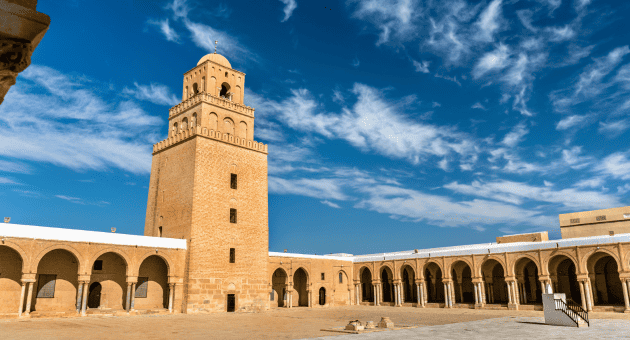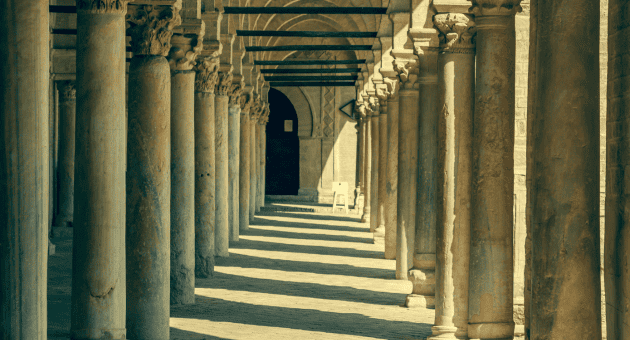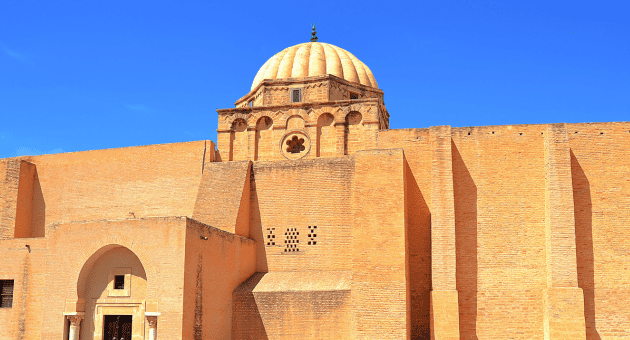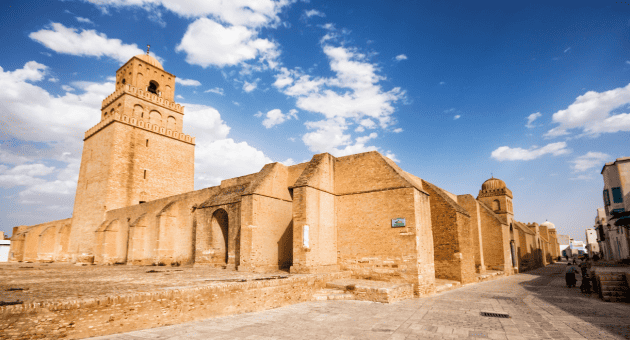The Great Mosque of Kairouan, located in Tunisia, is one of the oldest and most significant Islamic landmarks in the world. This magnificent mosque has a rich history and a unique architectural style that has influenced mosque design for centuries.
In this article, we’ll take a closer look at the history, architecture, art, and cultural significance of this historic mosque.
A Brief History of the Great Mosque of Kairouan

The Great Mosque of Kairouan was first built in 670 AD, just a few years after the arrival of Islam in North Africa. It was founded by Uqba Ibn Nafi, a Muslim general who conquered the region and established the city of Kairouan. The mosque was initially a small, simple structure, consisting of a central courtyard and a prayer hall facing Mecca.
Foundation and Early Development
Over the centuries, however, the mosque was repeatedly expanded and renovated, undergoing many transformations and additions. During the reign of the Aghlabid dynasty in the 9th century, the mosque was greatly expanded and beautified with the addition of new architectural features, decorations, and calligraphic inscriptions.
During this period, the Great Mosque of Kairouan became one of the most important centres of learning and culture in the Muslim world, attracting scholars, poets, and artists from across the Islamic empire. The mosque’s reputation for excellence in education and religious scholarship continued to grow throughout the centuries.
Expansion and Architectural Evolution
During the 9th and 10th centuries, the mosque underwent a series of massive expansions and renovations that transformed it into the impressive complex we see today. The prayer hall was enlarged and expanded, new administrative and educational buildings were constructed, and the famous minaret was added.
The minaret, the oldest in North Africa, is a masterpiece of Islamic architecture, rising over 31 meters high with a beautiful square base decorated in stunning geometric patterns and motifs. In the centuries that followed, the mosque continued to evolve, with further additions and renovations made by various Muslim dynasties, including the Fatimids, Zirids, and Almohads.
The Mosque’s Role in Islamic History
The Great Mosque of Kairouan played an important role in the spread of Islam throughout North Africa and beyond. It served as a centre of learning and religious scholarship, attracting scholars from across the Islamic world to study and teach at the mosque’s prestigious madrasas and libraries.
The mosque also played a crucial role in the development of Islamic art and architecture, with many of its features and design elements becoming iconic symbols of Islamic culture and identity. Today, the mosque remains a powerful symbol of Islamic heritage and tradition and continues to attract visitors and pilgrims from around the world.
Architectural Features of the Great Mosque of Kairouan

One of the most striking and iconic features of the Great Mosque of Kairouan is its architecture. The mosque’s unique blend of Islamic and North African architectural styles has influenced mosque design across the Islamic world and is noted for its beauty and elegance.
The Courtyard and Minaret
The central courtyard of the mosque is a large, open space surrounded by arcades with horseshoe arches and distinctive striped columns. The courtyard is surrounded by a covered gallery and features a large central fountain, which serves as a symbolic and practical element of ablution before prayer.
The minaret, located at the northwest corner of the mosque, is a square tower topped with a conical cap and is decorated with intricate geometric patterns and calligraphic inscriptions. It serves both a practical and symbolic function, providing a visual point of orientation for worshipers and symbolizing the mosque’s importance and elevated status.
The Prayer Hall
The prayer hall is the heart of the mosque and is characterized by its beautiful and intricate decorations, including stucco work, woodwork, and mosaics. It is covered by a large, flat, undecorated roof supported by a forest of columns, with the mihrab and minbar located at the centre of the qibla wall that faces Mecca.
The Mihrab and Minbar
The mihrab is a small, decorated niche in the qibla wall that indicates the direction of Mecca and is surrounded and adorned with intricate tilework, calligraphy, and inscriptions. The minbar, located next to the mihrab, is a raised platform from which the imam leads the congregational prayers and delivers sermons.
The Sahn and Surrounding Structures
The sahn, or courtyard, is an open space surrounded by galleries and minarets and serves as a functional and symbolic element of the mosque’s design. The surrounding structures include the library, the ablution area, and the madrasas, which serve as centres of learning and education.
Art and Decoration in the Great Mosque of Kairouan

The Great Mosque of Kairouan is renowned for its beautiful and intricate decorations, which reflect the rich history and cultural heritage of its Muslim builders and patrons. The mosque’s art and decoration feature a wide variety of motifs and styles, including geometric patterns, floral designs, and calligraphic inscriptions.
Intricate Tilework and Mosaics
The mosque’s walls and floors are decorated with a plethora of tiles and mosaics, featuring mesmerizing geometric patterns, religious inscriptions, and colourful floral designs. The tilework and mosaics are masterpieces of Islamic art and reflect the cultural and artistic diversity of the Islamic world.
Calligraphy and Inscriptions
The mosque’s walls and ceilings are covered with beautiful calligraphic inscriptions, featuring quotes from the Quran and other Islamic texts. The calligraphy is often intertwined with intricate geometric patterns and is considered one of the most important and expressive forms of Islamic art.
Woodwork and Carvings
The mosque’s prayer hall features beautiful woodwork and carvings, including the ornate wooden ceiling and the elaborately carved minbar and mihrab. The woodwork is a testament to the skill and creativity of the mosque’s builders and artisans and adds a warm and inviting aesthetic to the space.
The Great Mosque’s Cultural and Religious Significance

The Great Mosque of Kairouan is not just a beautiful and historic monument; it is also an important centre of cultural and religious significance for Muslims around the world. The mosque’s legacy and influence can be felt in the many Islamic traditions and practices that have been shaped by its teachings and example.
The Mosque as a Center of Learning
Throughout its history, the Great Mosque of Kairouan has served as a centre of Islamic education and scholarship, attracting students and scholars from across the Islamic world. Many of the mosque’s madrasas and libraries are still in operation today, providing students with access to a rich tradition of Islamic learning and intellectual exchange.
Pilgrimage and Tourism
The mosque’s reputation and significance as a centre of Islamic heritage and tradition have made it a popular destination for Muslim pilgrims and tourists from all over the world. The mosque’s impressive architecture, beautiful decorations, and rich history make it a must-see destination for anyone interested in the history and culture of Islam.
Preservation and Restoration Efforts
Despite its age and historical significance, the Great Mosque of Kairouan remains in excellent condition thanks to the continued preservation and restoration efforts of the Tunisian government and local conservation organizations. These efforts ensure that this important Islamic landmark will continue to inspire and educate future generations for many years to come.
Overall, the Great Mosque of Kairouan is a magnificent example of Islamic architecture and a testament to the rich history and cultural heritage of Islam. Its legacy and influence can be seen in the many mosques and Islamic structures that have been influenced by its design and aesthetic. Whether you are a student of Islamic history or simply a lover of beautiful architecture, the Great Mosque of Kairouan is definitely a destination worth exploring.


